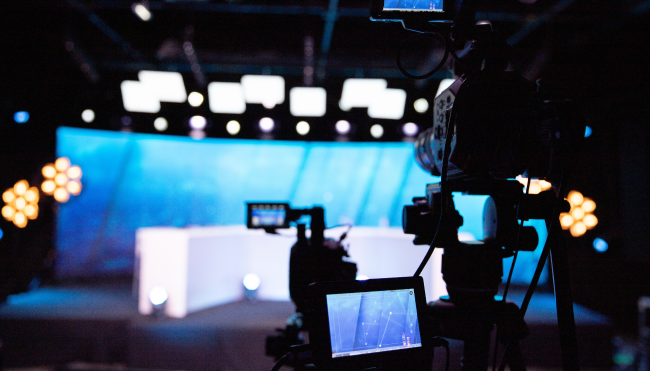- Why Amagi
-
Solutions
Contact UsBusinessWho We Serve
- Offerings
- AI
-
Resources
Contact UsINDUSTRY REPORTSAmagi FAST Report #15: The Power of Live Programming: A Catalyst for Streaming SuccessAugust 21, 2025Read More
-
Company
Contact UsNewsroomAmagi launches AI-powered Smart Scheduler to improve content programmingApril 3, 2025Read More
Blog
Elevate channel programming with AI-driven automation
By Gokul Muralidharan, - September 19, 2025
In a market where content volume is surging and viewer expectations are evolving, OTT Studio has built a niche — over 17 million organic installs and 20+ owned-and-operated brands — by mastering CTV discoverability and efficient programming. In this exclusive Amagi AIRTIME webinar conversation, Co-founder and CEO of OTT Studio Ryan James joins Amagi’s Gokul Muralidharan to share how the company transitioned from time-intensive manual scheduling to scalable, AI-powered programming. They also discuss organic growth, personalized content strategies, reshaping the future of FAST, and more.
Read on for highlights and watch the entire webinar here.
Muralidharan: Most of your flagship channels’ traffic has been built organically. Could you share some learnings there?
James: We own and operate north of 20 streaming brands that are live primarily on CTV, Roku, Vizio, and Fire TV, and we have spent very little in marketing over the years — mostly 100% organic growth or let's call it 98% organic growth. We've amassed over 17 million installs organically across the portfolio of apps and brands. It's mostly been due to what we call — CTV SEO — and creating strong brands that are driven by high-value keyword search terms. We have a brand called Free Movies Plus — you go on to these platforms, you search for free movies, and you'll find our brand.
Muralidharan: How many channels does OTT Studio have, and how are they programmed today?
James: We have about 20 owned and operated channels, and then there are a few additional channels we power and operate for media brands as well. Most of them live as FAST channels, probably distributed in the market. How we got going as we built a streaming app for a brand, and as it succeeded, we've then built out a supplement to a FAST strategy for that brand or channel. We started out as an AVOD play, building out a lot of applications. And more recently, in the past few years, we have gotten into the FAST space, and we started out by launching FAST channels for some of our flagship brands.
As we looked at our library, we had a really deep library of content, and it was spread across a lot of different brands and genres, and it just made sense to kind of replicate the FAST strategy that we had for our flagship brand across all our other genre-specific brands, as well. And when you're doing that in your lean team, there are a lot of challenges and complexities that come with being efficient and programming channels efficiently and in a way that will attract consumers and be scalable for your business operation.
READ: Metadata best practices for FAST programming
Muralidharn: Before automation, what challenges did the channel programming team face?
James: One of the biggest challenges is time — to program a quality channel requires sitting down, understanding the content in a very deep way, mapping connections between different titles, and building out program blocks that make sense together. And just kind of rolling up your sleeves and doing the grunt work to program out quality content. And then you have to track the performance of these different channels and adjust, and you have to do that on-the-fly in real time, making smart decisions based on the data you're getting from these different platforms and from consumer engagement.
CASE STUDY: How OTT Studio improved FAST channel scheduling
Muralidharan: How does your team balance human curation versus AI automation?
James: When we first got going, we treated content programming as an art. We thought we knew best, and we could get creative with it. But there really is a lot of science that needs to go into a great programming and scheduling strategy. And having a system that can kind of blend the two has been our focus. We lean heavily on the Smart Scheduler to analyze insights and data and build out an initial program for us, and then we're able to go in after the fact, review the program that's been created, and fine-tune or adjust as we see fit.
Muralidharan: What are your thoughts on personalized channels? Do you think they will significantly change how the FAST industry works?
James: Yeah, I think so. I think being able to just turn on a TV and have one channel that is always tuned to my personal interests and the larger content ecosystem, and surfacing the right show to me at the right time — it seems like a great experience and a great opportunity. I could also see a world where an EPG gets smarter as well. Right now, a user lands on a program guide and there are dozens, hundreds of channels, and there's a consumer who probably loves channel 400, and they have to scroll through the mess to find that channel they love. So, figuring out a way to reshuffle the EPG order based on user actions and user preferences, I think that'd be really interesting.
Muralidharan: Where do you think AI could help in other areas?
James: I think personalization is a huge one. I think that right now, Netflix does a great job at personalization and recommendations, and it's something that we're starting to see that quality of personalization and recommendations trickle over to the smaller, independent services as well.
Monetization is a space right now that everyone is focused on. And when AI can come in and personalize ads at a deeper level, I see a lot of synergy for improving the experience and also improving the financial bottom line of a business.
Want to learn more?
- Talk to us to transform programming with Amagi Smart Scheduler
- Read our latest Global FAST Report here
- View our full webinar series here
Related Blogs
Get started
Increase revenue and reach with our Broadcast & Streaming solutions.
Cloud modernization. Streaming unification. Monetization. Marketplace.
 German
German French
French Spanish
Spanish Korean
Korean Japanese
Japanese Portuguese
Portuguese


